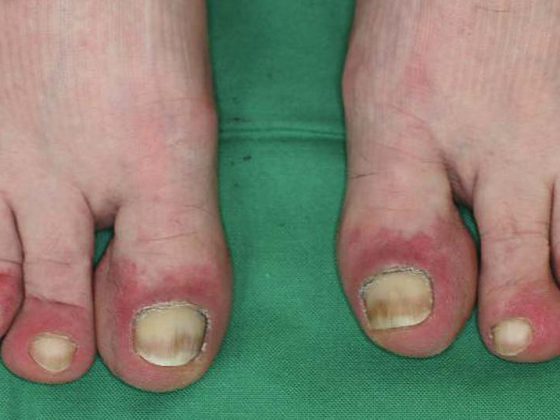Dermatology Basel looks back on an eventful history. For example, until 1978, inpatients with skin and sex disorders were segregated by gender, and Theophrastus Bombastus von Hohenheim was not recognized at the university in the 16th century. However, the first description of epidermodysplasia verruciformis and the author of the famous “Lehrbuch der Haut- und Geschlechtskrankheiten” (Textbook of Skin and Sexually Transmitted Diseases) also came from the city on the Rhine bend.
The history of dermatology in Basel can be divided into different time periods. The first period concerns the time between the foundation of the University of Basel in 1460 and the establishment of the separate Department of Dermatology at the University Hospital Basel in 1908. This aspect was extensively reviewed by Prof. Theo Rufli with the help of historical documents of the Medical Faculty and the annual reports of the Bürgerspital Basel and published in his book “Die Geschichte der Dermatologen und der Dermatologie an der Universität Basel 1460 bis 1930”. The second period of the history of dermatology at the University of Basel then extends from the founding of the Department of Dermatology to the present day.
Paracelsus in Basel
In 1527 Theophrastus Bombastus von Hohenheim, also known as Paracelsus, came to Basel. He was appointed as city physician by the Basel City Council, but the council had not informed the university accordingly. Paracelsus had assumed that he would not only be a city doctor, but also a full professor for the medical faculty at the University of Basel. The Basel faculty, however, did not accept him. He had to leave the city again in 1528.
In the field of dermatology and venereology, Paracelsus established several misconceptions. He assumed that gonorrhea represented the first phase of syphilis. This concept was maintained for more than 200 years. During this period, patients with infectious diseases, including sexually transmitted diseases and skin diseases, were treated in so-called infirmaries, which were located outside the city walls.
In 1842, a new building was opened for the Bürgerspital Basel and a division for the treatment of patients with skin and venereal diseases was opened in the Markgräflerhof on the north and south wings. The north wing was for women, the south wing for men. This separation of the sexes was maintained in the outpatient clinic as well as among inpatients until 1978. Separate waiting rooms were maintained until the late 1980s. Since 1897, skin diseases were treated in separate departments within the Department of Internal Medicine at the Bürgerspital Basel. During this time, the head of this subdiscipline within Internal Medicine was Prof. Jaquet.
Around 1900
In 1898, 256 hospitalized patients were treated at Dermatologie Basel. Since 1905, Dr. Bruno Bloch was responsible for dermatology. In the annual report of 1906, an interesting anecdote is quoted: “… an unexpected increase in the workload was observed in the Dermatological Clinic, especially by the Polyclinic, due to the increasing number of fungal diseases of the hair in young people.” The report noted that a special room was created where radiotherapy of these hair diseases could be performed. This X-ray machine became a central part of dermatology at this time.
In 1908, a department for skin diseases was founded within the Bürgerspital independently of internal medicine; Dr. Bruno Bloch became head of this department. On October 1, 1908, he became a professor. From 1916 until his death, he was then full professor and the first full professor of dermatology and venereology in Zurich. Bloch had worked scientifically in various fields including mycology, pigmentary diseases, eczema disorders and allergic reactions.
First description of epidermodysplasia verruciformis
The time of Prof. Lewandowsky (1918-1922), the successor of Bruno Bloch in Basel, is particularly associated with the first description of epidermodysplasia verruciformis in 1922. The original patient numbers 2 and 3 were treated by Wilhelm Lutz, Rudolf Schuppli and also Theo Rufli, and currently the third patient is under the treatment of Prof. Peter Itin in the Department of Dermatology at the University Hospital Basel. Our research laboratory is working on the genetic background of epidermodysplasia verruciformis and the causes leading to squamous cell carcinoma development in these patients.
Prof. Lewandowsky was particularly interested in skin infections, having worked on tuberculosis of the skin, leprosy, and Staphylococcus aureus infections as causes of impetigo contagiosa before coming to Basel. The Department of Dermatology at the University Hospital of Basel had 57 beds under Lewandowsky.
In 1920, a laboratory for light therapies was established and a new X-ray machine was installed, along with two Finsen lamps, two Kromayer quartz lamps and a Hanau mercury vapor lamp. Prof. Lewandowsky died in 1922 as a result of colon carcinoma.
“Textbook of Skin and Venereal Diseases.”
After the untimely death of Felix Lewandowsky, Arndt, Jadasson and Miescher were evaluated together with Lutz as the new heads of Dermatology Basel. Kyrle, who had declined the call to Basel in 1918, was no longer included in the list of candidates. In the end, the University of Basel decided to put Prof. Wilhelm Lutz on the first position of the shortlist, Miescher was put on the second position. The time with Prof. Lutz (1922-1956) was illustrated in Prof. Theo Rufli’s book by means of anecdotes and reports which Prof. Rufli had received from Lutz’s daughter, but also from Lutz’s students Rudolf Schuppli and Ferdinand Wortmann. Wilhelm Lutz’s parents ran the famous Hotel Krafft in Basel. He lost his father at the age of ten and his mother at the age of 19. For this reason, he had to run the hotel in addition to his duties as clinic manager until his younger brother was able to take over.
The scientific work of Wilhelm Lutz was quite broad and included a contribution to the biology of X-rays. Another area of interest for Lutz was pigmentation. In addition, he worked to better understand infections of the skin including tuberculosis. Furthermore, he was interested in the cutaneous adverse effects of drugs and also eczema reactions. However, his most important publication was the description of epidermodysplasia verruciformis, together with Lewandowsky. From 1937 he was editor of the International Journal Dermatologica. In 1951 his famous “Lehrbuch der Haut- und Geschlechtskrankheiten” was published by Karger Verlag Basel. In this book he already described the typical clinical signs of pemphigus vulgaris. Today these signs are called Nikolski phenomena. After a heart attack, Lutz became emeritus in 1956. Two years later he died.
Expert in dioxin disaster
In 1956, Prof. Rudolf Schuppli (1956-1985) was elected chief physician and full professor of dermatology. He was born in Moscow and came from a family that had emigrated from Switzerland and then returned to Switzerland as refugees in 1918. Rudolf Schuppli began studying medicine at the age of 18, graduating in 1939. In 1947 he habilitated in Basel. Prof. Schuppli’s scientific work was very broad and very clinically oriented. He had a particular focus on allergology, with a special interest in antigen and antibody responses, as well as the effects of mast cells. Schuppli was very active in the field of syphilis therapy and also prevention. He ran an anonymous diagnostic center for homosexual patients. During his active period, Schuppli observed increasing resistance of gonorrhea to penicillin. Another important research topic of Schuppli was the development of protective ointments for patients with hand eczema. The ointment contained ion exchangers, which were supposed to help patients with chromate eczema (mason’s eczema). In addition, Schuppli was committed to leprosy and published various papers in this field. Later, he investigated why continuous immunostimulation, e.g., in patients with severe contact sensitization, can lead to T-cell malignancy. He created the term “immunome” for this development.
Schuppli was an excellent clinician and didactician and was also called in as an expert during the dioxin disaster in Seveso because he had described keratosis follicularis epidemica in the journal Dermatologica in 1947 after an accident in the pharmaceutical industry in Basel, which had been interpreted as a consequence of dioxin contamination of the air. Schuppli was also a pioneer in the introduction of systemic retinoids for psoriasis and acne. Prof. Theo Rufli knew Prof. Schuppli since 1969 and has given a very authentic account of his era in his book. I myself experienced Prof. Schuppli and then Prof. Rufli as my formative mentors during my residency.
Start of the AIDS epidemic
Prof. Theo Rufli served as Head of Dermatology at the University Hospital Basel from 1986-2005. His primary interests were sexually transmitted infections. Later he developed a special expertise, but also an enthusiastic interest in the field of enthymology. In these fields he was the most important expert in Switzerland, and he also became internationally known.
With the onset of the AIDS epidemic, he became particularly concerned with cutaneous manifestations in HIV-infected patients. He was an extremely successful and much-appreciated speaker and, as a result, was hailed by his students as an excellent teacher. In 2005, Prof. Rufli retired and passed away in 2007.
The road to genodermatoses
In 2005 the Interregnum started under the direction of Prof. Stanislaw Büchner and Prof. Andreas Bircher. In the second half of the year, Prof. Bircher ran the clinic alone, as Prof. Büchner went into private practice in Basel. The further development of the clinic from a purely morphologically oriented institution to a modern, scientifically and also molecularly oriented department was started by Prof. Rufli and continued by Prof. Peter Itin, who took over the department in July 2006. In 2007, a research laboratory focusing on genodermatoses was established and located within the Department of Biomedicine in Basel.
At present, PD Dr. Peter Häusermann (mainly responsible for dermatohistopathology) and Prof. Andreas Bircher (Head of Allergology) are the leading physicians at Dermatology Basel. In 2013, Dr. Susanna Fistarol-Bohn (general dermatology, autoimmune diseases, stomatology), Dr. Andreas Arnold (psoriasis, melanoma), Dr. Andreas Volz (dermatosurgery, laser therapy), PD Dr. Marcel Müller (wound healing and informatics) and PD Dr. Kathrin Scherer Hofmeier (allergology, contact eczema) served as senior physicians. Ten assistants in different levels of training are active at the clinic, two assistants are in allergology and clinical immunology and one assistant is on a rotation at the Cantonal Hospital Aarau every six months. Since Prof. Itin took over dermatology in 2006, services have been expanded and, on the other hand, training activities have been adapted in line with the Bologna reform. In the field of genodermatology, scientific work is being carried out on fundamental questions, and in allergology, in vitro tests are being used to investigate allergological phenomena.

Changes within the last years
Prof. Bircher has adapted the lecture in dermatology and venereology to the Bologna reform. Since 2006, dermatology and its faculty have consistently been nominated by students as Teacher of the year. Another aspect concerns the clinically sound training of new specialists. The clinic also invests considerable time resources in this tradition. The curriculum has been adapted so that each residency candidate rotates through the various subspecialties for six months. This is an extremely difficult task organizationally, which is coordinated by PD Dr. Häusermann, the certified histopathologist. Since 2006 a dermatosurgery was installed, which is currently operated by Dr. Andreas Volz. He is also responsible for continuing education in this area. The laser park was significantly expanded and a UVA1 irradiation unit was also acquired. Furthermore, a new X-ray irradiation unit was purchased that meets modern requirements.
Together with the biologist Dr. Bettina Burger and later Dr. Iris Spörri, the research laboratory was founded at the Department of Biomedicine in Basel. Dr. Andreas Arnold is also active as a clinician in research on genodermatoses. He has freshly received the venia docendi.
Prof. Bircher, together with PD Dr. Kathrin Scherer, has very successfully continued research on the topic of “undesirable drug side effects on the skin”. The number of clinical trials is also being maintained, although regulatory requirements in dermatology and allergology are becoming increasingly burdensome.












